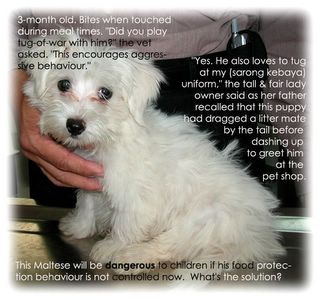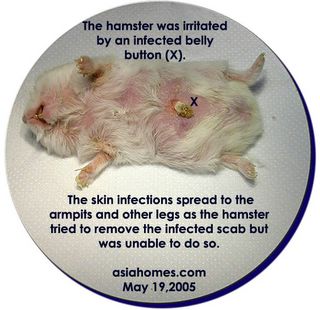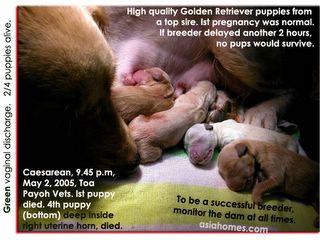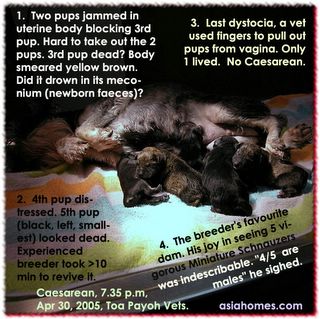DRAFT COPY. FOLLOW UP NEEDED.
"The policeman took away my Maltese," Ms Cook wiped the tears off her eyes as she sat down and put her elbows on the consultation table. "The humane shelter was handed the Maltese and I am forbidden to see him. The person who reported that I stole her Maltese will be meeting the humane shelter people today at 3 p.m"
Ms Cook was given the Maltese by her boy friend around 6 weeks ago. Her neigbhour accused her of stealing the Maltese 2 weeks ago. So, she had consulted 2 vets, including myself, wanting to know how old the Maltese was. The first vet had certified that he was 3 years old. I examined it and estimated he was 2 to 3 years old, male with undescended testicles and had a microchip number.
Ms Cook told me that the complainant had said her Maltese was "one year old, male".
"Was it neutered?" I asked Ms Cook during the first consultation. She was not sure. Well, this Maltese did not have scrotum (the bag holding the testicles). That was why I described him as having "undescended testicles". So, he was not an intact male. Neither was he neutered.
Now, Ms Cook came to ask how she could prove that the Maltese did not belong to her neighbour. She had consulted her lawyer who said that the Agri-Food and Veterinary Authority (AVA) would be able to identify the owner of the Maltese since he was micro-chipped.
"Not in this case," I said. "Unless the Maltese had been given a dog's licence." Since both parties had not applied for a dog licence, the AVA would be unaware of his existence.
I continued, "In fact, the AVA officer would fine the owner $500 for not getting the dog licensed after it is 3 months old."
Ms Cook said, "The Maltese was found in Pasir Panjang (West of Singapore), far away from Ang Mo Kio (Central Singapore) where it was lost. My friend is willing to testify to that."
"The dog could have been found by somebody and then abandoned or lost at Pasir Panjang." I replied. "In any case, your friend could not be considered a reliable witness since he would have sided with you."
So, what should she do now? Would her Maltese get infected with diseases since he was impounded in the humane shelter where there are many dogs, healthy and sick? What should she do to get her dog out?
"Your Maltese would be released in the next 2 days," I predicted. "The humane shelter veterinarian would age the Maltese. The important issue is whether he is 1 year old or 3 years old. There is a lot of difference and the decision should be quite clear."
Would the humane shelter officer be as wise as King Solomon? In a dispute as to who is the mother of a baby, King Solomon ordered that the baby be killed. The real mother did not want the baby killed, wanting to let the other party have the baby.
This Maltese definitely did not look like one year old. Yet, my heart goes to the owner of the lost Maltese.
"Did the Maltese run back to the complainant when called?" I asked Ms Cook.
"He runs to anybody," Ms Cook said. "He just want to be friends with everybody."
That path could not be taken. The humane shelter officer would have to decide based on the age given by 3 veterinary surgeons. If the humane shelter veterinarian who is a neutral party said that the Maltese was 3 years old, Ms Cook would have her dog back and an angry neighbour.
My heart still goes to the complainant although I had not been contacted by her. I had never met her or maybe I had vaccinated her Maltese. I checked the Internet for "Singapore Maltese." Surprisingly, there was reported a lost Maltese in Ang Mo Kio in April 2005 in a website which provides free postings for lost dogs globally.
FOR READERS who are not familiar with Malteses, below is a picture of how a Maltese looks like at 3 months old.

Many Maltese look alive. How to prove to the policeman that the lost Maltese is yours? The policeman can't do it. He asks the humane shelter to handle the case.
http://www.toapayohvets.comIS THE MICROCHIP A RED HERRING
Further to my posting on:
Thursday, May 12, 2005
"The policeman took away my Maltese," Ms Cook wiped the tears off her eyes as she sat down and put her elbows on the consultation table. "The humane shelter was handed the Maltese and I am forbidden to see him. The person who reported that I stole her Maltese will be meeting the humane shelter people today at 3 p.m"
7 days have passed. The Maltese ownership was not resolved. Apparently, the humane shelter had 2 of its vets to ascertain that the Maltese was 3 years old. They were independent veterinarians. The first owner said her Maltese was 1.5 years old. I had said it was 2-3 years old on behalf of the second owner who had been given the Maltese. The second owner had another vet certified that it was 3 years old.
I guessed the case was handed back to the police as I received a phone call from the police station.
"Since the independent vets said the Maltese was 3 years old, there is a lot of difference between 3 years old and 1.5 years old," I said.
The policeman did not say anything but I read his thoughts, "I don't believe you."
"Do you have children?" I asked the policeman. "Can you tell the difference between a 1.5-year-old toddler and a 3-year-old child?"
"I do not have children," the policeman said.
"You are fortunate," I said. "It has become too expensive and stressful to bring up children in Singapore with so many needing expensive tuition."
The policeman repeated twice, "I am very unfortunate."
"Well," I did not know what to say. "Dogs mature much faster. One dog-year is equivalent to 7 human-years. Therefore a 3-year-old Maltese is grown up and definitely is so much different from a 1.5-year- old. A similar aged child is also easy to tell apart."
The policeman was cautious. "We have to be sure."
"This Maltese has a micro-chip identified by you," the policeman said. The micro-chip was only useful if the first owner had micro-chipped the Maltese but it was not done. It was presumed that the second owner had micro-chipped the Maltese and that it was done by me.
I said, "The other private vet whom the second owner consulted had also certified stated the same microchip number in his letter." The spotlight was on me as I had scanned the dog and stated its microchip number.
Apparently, the police did not have this information.
"In any case, the micro-chip is a red herring. It has NO useful data on who owns the dog since the registry has no information."
I did not say the "red herring" because the policeman would not understand and I doubt most Singaporeans are familiar with this idiom. In any case, Singaporeans are not familiar with the herring which is a valuable food fish for Europeans.
Every investigative body involved focused on the micro-chip number and who had micro-chipped the dog or had ownership records. Anybody can microchip a dog. There is no legal requirements that only authorised people can microchip a dog in Singapore in 2005.
The veterinary regulatory authority had no record of the ownership of this number. I don't have the record of this too when I was phoned. Neither the other veterinarian or the humane shelter veterinarians. So, was this Maltese fated to be detained indefinitely at the humane shelter?
The first owner had not micro-chipped the Maltese, otherwise, this case was an open and shut case of ownership dispute for the police who would not have to refer to the humane shelter. The second owner was very stressed. She went to the humane shelter and kept following up the case almost daily. She asked me for advices but there was nothing I could help as the Maltese was detained too long in the humane shelter. She was willing to pay for another veterinarian to certify the age of the Maltese. She has a lawyer who does not know much about lost puppy litigation.
What can be done now? It was distressful for the first and second owner. I hope the matter can be resolved amicably. One party would have heart breaks. If only the first owner had micro-chipped the Maltese. The cost is $30.00 - $50.00 at the veterinary practices, but not many Singaporeans are interested.
DRAFT. FOLLOW UP. CASE STILL NOT CLOSED.
IS THE MICROCHIP A RED HERRING
Further to my posting on:
Thursday, May 12, 2005
"The policeman took away my Maltese," Ms Cook wiped the tears off her eyes as she sat down and put her elbows on the consultation table. "The humane shelter was handed the Maltese and I am forbidden to see him. The person who reported that I stole her Maltese will be meeting the humane shelter people today at 3 p.m"
7 days have passed. The Maltese ownership was not resolved. Apparently, the humane shelter had 2 of its vets to ascertain that the Maltese was 3 years old. They were independent veterinarians. The first owner said her Maltese was 1.5 years old. I had said it was 2-3 years old on behalf of the second owner who had been given the Maltese. The second owner had another vet certified that it was 3 years old.
I guessed the case was handed back to the police as I received a phone call from the police station.
"Since the independent vets said the Maltese was 3 years old, there is a lot of difference between 3 years old and 1.5 years old," I said.
The policeman did not say anything but I read his thoughts, "I don't believe you."
"Do you have children?" I asked the policeman. "Can you tell the difference between a 1.5-year-old toddler and a 3-year-old child?"
"I do not have children," the policeman said.
"You are fortunate," I said. "It has become too expensive and stressful to bring up children in Singapore with so many needing expensive tuition."
The policeman repeated twice, "I am very unfortunate."
"Well," I did not know what to say. "Dogs mature much faster. One dog-year is equivalent to 7 human-years. Therefore a 3-year-old Maltese is grown up and definitely is so much different from a 1.5-year- old. A similar aged child is also easy to tell apart."
The policeman was cautious. "We have to be sure."
"This Maltese has a micro-chip identified by you," the policeman said. The micro-chip was only useful if the first owner had micro-chipped the Maltese but it was not done. It was presumed that the second owner had micro-chipped the Maltese and that it was done by me.
I said, "The other private vet whom the second owner consulted had also certified stated the same microchip number in his letter." The spotlight was on me as I had scanned the dog and stated its microchip number.
Apparently, the police did not have this information.
"In any case, the micro-chip is a red herring. It has NO useful data on who owns the dog since the registry has no information."
I did not say the "red herring" because the policeman would not understand and I doubt most Singaporeans are familiar with this idiom. In any case, Singaporeans are not familiar with the herring which is a valuable food fish for Europeans.
Every investigative body involved focused on the micro-chip number and who had micro-chipped the dog or had ownership records. Anybody can microchip a dog. There is no legal requirements that only authorised people can microchip a dog in Singapore in 2005.
The veterinary regulatory authority had no record of the ownership of this number. I don't have the record of this too when I was phoned. Neither the other veterinarian or the humane shelter veterinarians. So, was this Maltese fated to be detained indefinitely at the humane shelter?
The first owner had not micro-chipped the Maltese, otherwise, this case was an open and shut case of ownership dispute for the police who would not have to refer to the humane shelter. The second owner was very stressed. She went to the humane shelter and kept following up the case almost daily. She asked me for advices but there was nothing I could help as the Maltese was detained too long in the humane shelter. She was willing to pay for another veterinarian to certify the age of the Maltese. She has a lawyer who does not know much about lost puppy litigation.
What can be done now? It was distressful for the first and second owner. I hope the matter can be resolved amicably. One party would have heart breaks. If only the first owner had micro-chipped the Maltese. The cost is $30.00 - $50.00 at the veterinary practices, but not many Singaporeans are interested.










